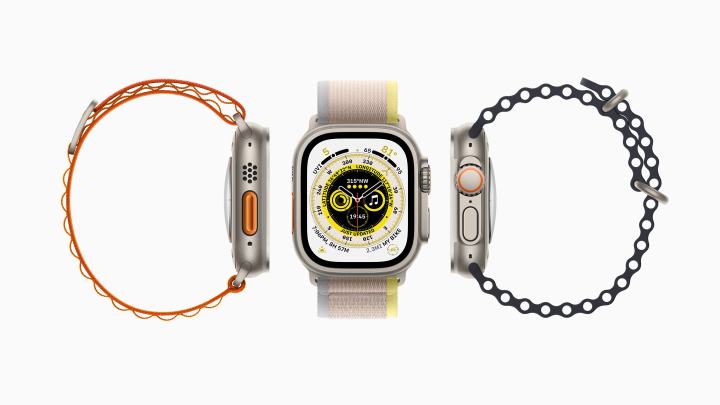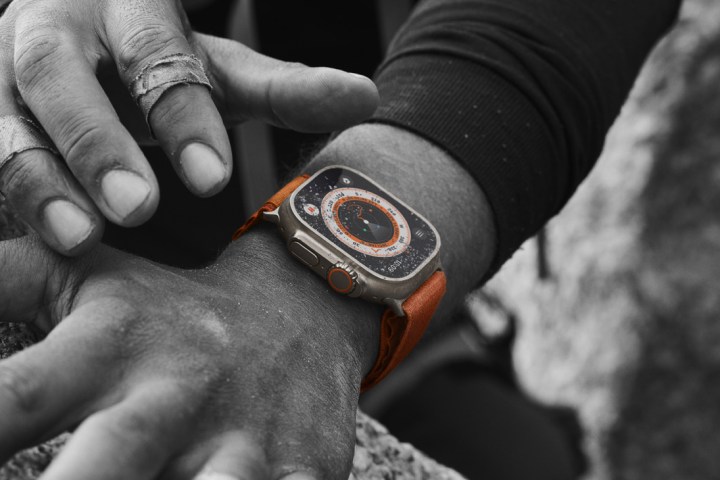Apple’s Watch Ultra is going on sale this week, and a flood of reviews have hit the internet, evaluating the company’s most expensive smartwatch. This comes following the company’s release of the iPhone 14, 14 Pro, 14 Pro Max, and Apple Watch Series 8.
Pending our own review in the coming weeks, we’ve looked at our colleagues in tech, lifestyle, and sports media to get a feel of the consensus that’s formed around this watch.
A weighty affair

The biggest thing about the Apple Watch Ultra (other than its price) is that it’s big. It’s the biggest Apple Watch by a wide margin at 49mm, and the results on its size are mixed. Obviously, how well you can wear the watch depends on how large your wrists are. There’s also universal agreement that this is not an insubstantial watch.
“When taking the Ultra out of the box for the first time, I thought it was going to be too large and heavy for my wrist. But it’s deceptively light to wear, thanks to its titanium construction. Even with the smallest watch strap that best suits my wrist size, I’m able to get a snug and comfortable fit during the day,” CNET’s Lexy Savvides says.
“If you’re used to the smaller Watch, or are upgrading from the Watch 3, the Ultra will feel gargantuan and a little heavy to start with. However, we got used to this extra size and heft so quickly, and the trade-offs are worth it,” TechRadar’s Gareth Beavis wrote.
“For people with extremely petite wrists (under 130mm around), the Ultra just may not be physically possible — and even some folks with larger wrists don’t want a huge, honking watch,” The Verge’s Victoria Song writes.
The best battery in an Apple Watch so far

The Apple Watch is no Fitbit or Garmin. It’s typically been limited to just around a day of battery life, but the Watch Ultra pushes past that. Apple says it’s rated for up to 36 hours of use (which means you can use it all day and then some), with a low-power mode in WatchOS 9 to push that even further. Reviewers found that the Apple Watch Ultra did meet those expectations, but it still paled in comparison with “proper” hiking watches.
“The battery life, while increased to 30 hours (and we got far more in testing), is still woefully short compared to the best that Garmin and Coros have to offer — those watches can last for days in standby mode, where Apple’s push for functionality comes at a high cost to battery life. If Apple had managed to alter the screen technology somehow to have a truly low-power mode when not in use, and managed to get the Watch Ultra battery life up to around a week, this would probably be a five-star device, even for the high cost. As it stands, that battery issue might not be insurmountable, but it’s one that’s disruptive — you’ll still need to figure out a ‘charging dance’ daily that allows you to make use of all the health-tracking and fitness features without being shorn of your Watch Ultra ata key time.” TechRadar’s Beavis explained.
“While many of the Ultra’s features are impressive, the 36-hour battery estimate (and 60 on low power), a massive step for an Apple Watch, is still low. Many peer devices have battery estimates that are markedly longer — Garmin’s official social media channel seemingly trolled Apple when the Ultra’s specs were announced, tweeting that its devices measure battery life in “months, not hours — and battery life is among the most important features for outdoor devices,” Brett William’s wrote for men’s lifestyle magazine Men’s Health.
“The Ultra will handle a weekend trip, but it’s not going to outlast a Garmin or Polar if you want to go on a weeklong backpacking trip. Of course, you don’t need to justify wanting better battery life. It’s simply something to factor in when you’re deciding which watch to get,” The Verge’s Song wrote.
Apple’s done a lot better with the Watch Ultra than it did with the Series 8, sure, but it certainly still has room to grow in the battery department.
More aspiration than perspiration?

So, while the $799 Apple Watch Ultra is billed as a smartwatch for fitness and hiking enthusiasts — which most tech bloggers aren’t equipped to truly test. Ray Maker at DCRainmaker has a really in-depth review of the Apple Watch Ultra that I’m hesitant to truncate, but he did do the gritty work of taking it into the Alps to put it through its paces for an ultra-style adventure.
“Despite taking the Apple Watch Ultra on this grand 14-hour Alps adventure yesterday, it didn’t actually serve much of a purpose. Meaning, it wasn’t the one navigating me to the finish line, pacing me up three-hour climbs, or helping me find my way in the pitch-black dark. My Garmin Epix watch was. The Apple Watch was (mostly) dutifully recording that trek, but it wasn’t providing much actionable information. Apple needs to find a way to have the Ultra be the key to successfully completing these sorts of adventures, and the primary path to that is a robust navigation component,” Maker wrote.
He also identified the touch orientation of the Apple Watch, despite the Ultra’s action button, as a flaw. “Too many scenarios on the watch still require touch inputs — something that’s often impossible in rain, snow, cold weather conditions, and more. I shouldn’t ever have a situation on the Ultra where my run/hike/adventure gets ended simply due to a wet jacket briefly touching the display for a second. That should be a button, and a confirmation via another button,” Maker says.
The Wall Street Journal’s Nicole Nguyen also took the Ultra out to the mountains, testing its battery claims as well as its outdoorsy prowess. “It’s no Garmin killer. Besides navigation, Garmin watches support other features important to serious athletes that are missing in the Apple Watch, such as recovery metrics and the ability to broadcast heart rate to workout equipment via Bluetooth,” Nguyen wrote, adding: “I think it’s great for the active — but not the most extreme — athletes. Sure, it’s nice on a long hike, but it can also unlock your Mac.”
The Apple Watch Ultra is a possible game changer

Apple is known for changing the game, though it’s losing that power somewhat. High-resolution cameras and always-on-displays introduced in the iPhone 14 Pro are something Android phone owners would be rather blasé about. What’s different, then, is the company often pushes the boundaries of what can be expected from a product and how much we can pay for it. Apple has opened the barn door for ultra-premium extreme smartwatches that compete with regular watches in pricing and kinda-sorta features wise too. Expect Samsung, Huawei, and Oppo to begin work on $799 smartwatches as well. And now that we can expect watches to be larger, you should also expect watches to come in larger sizes.
The Apple Watch Ultra isn’t a perfect product — one of its killer apps is a compass. That may well be apt, as it’ll ultimately tell us where the market is going next.



